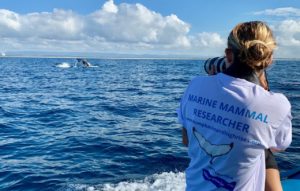New research has confirmed what migrating humpback whales get upto when passing through two key stopoverson the East Australian Coast.
Dr OlafMeyneckefrom Griffith University’sWhales in a Changing Climate ResearchProject and Coastal & Marine Research Centre led thestudy of the humpback behaviour documented in the Gold Coast Bay and Hervey Bay regions.

Dr Olaf Meynecke.
DrMeyneckeand the research team analysed long-term citizen science data collected fromnot-for-profitorganisationsHumpbacks &Highrises(Gold Coast) and theOceanaProject (Hervey Bay), studying the movements and behaviours of 5400 humpback whales during their migration through the two regions.
The research, which has been published inMarine & Freshwater Research,includes humpback whale data fromHervey Bay between 1999–2009and the Gold Coastbetween 2011–2018.
“This is the first study to look at the behaviour of humpback whales in two different regions to determine how they use the areas,” DrMeyneckesaid.
“It showed that the whales used the two bays for many similar activities, such as resting andsocalising, but that there were distinct differences.
“We found more competitive groups and aggressive behaviours in the Gold CoastBay, whereas the results support the findings from earlier research for Hervey Bay, showing that it is predominantly a resting area for mother-calf pairs.
“In the GCBaywe also have the mother-calf pair resting, but the area is much easier to enter for males and doesn’t require much of a detour.
“Overall, our results suggest that the GC Bay provides habitat for a wide range of criticalhumpback whaleactivities,in particular forresting mother-calf pairs, mature whales seeking copulation and socialising immaturewhales.

Courtesy of Humpbacks & Highrises.
“Hervey Bay had a higher number of mother-calf pair sightings, confirming the areas an important resting site.”
Sarah McCullochfrom Griffith’s Coastal and Marine Research Centresaid it wasimportant to understand why a specieswasutilising a habitat.
“What behaviours are they performing there, what forms of socialisation are they engaging in, and how important are these behaviours for their fitness andsurvival?” she said.
“Utilising volunteers through citizen science programs, and partnerships with the whale watching industry, we are able to collect data almost everyday during the humpback whale migration season. The community has a great interest in our wildlife and the conservation of species, especially humpback whales.”
DrMeyneckesaid the studydemonstrated that the two regions were critical for humpback whales during their annual migration, but for different essential activities, and should be considered as whale protection areas.
‘Humpback whale (Megaptera novaeangliae) behaviour determines habitat use in two Australian Bays’ has been published inMarine & Freshwater Research.

